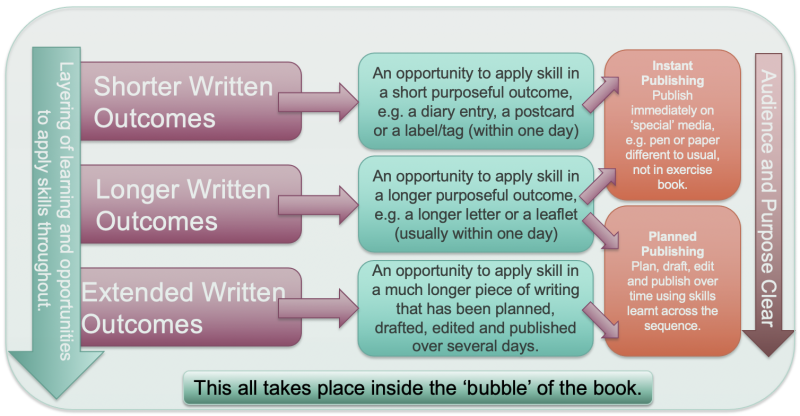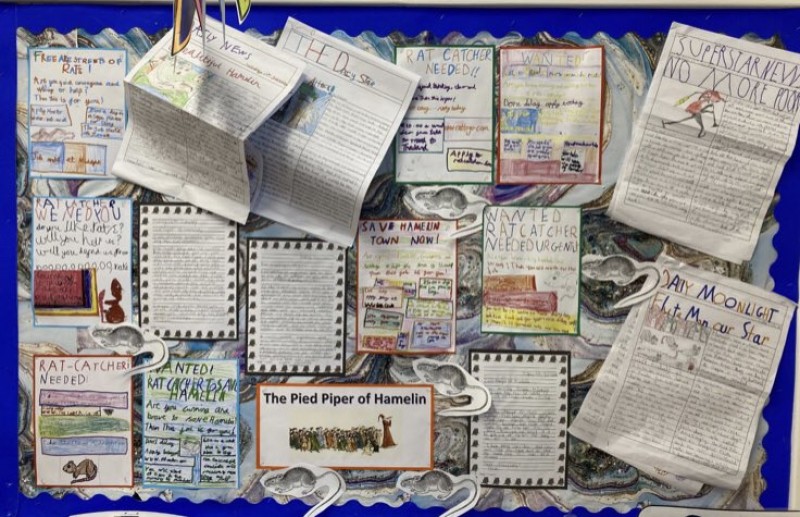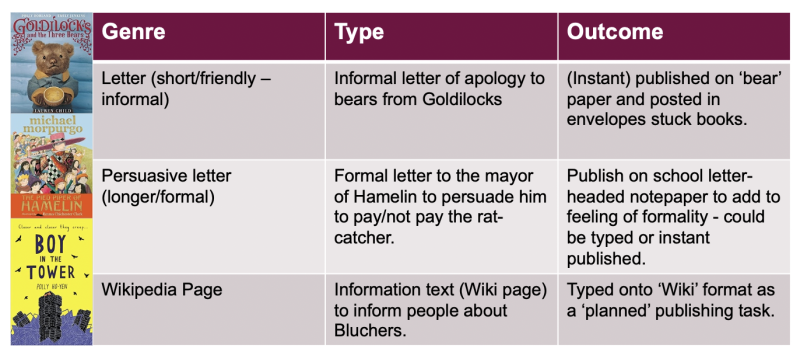Posted on: 10/02/2022
Every resource we write, that forms part of the Literary Curriculum, uses the book as the main driver for any writing that takes place within the sequence. Each sequence journeys through the text and we ensure the writing outcomes match the part of the book the children have reached so that there is a strong context for purposeful writing to take place. Alongside this, we’ll always teach the right skill for writing (whether grammar, vocabulary or composition) at the right point to match the writing that takes place. All of this takes place within the 'bubble' of the book.
As children travel through each book and sequence they will meet a number of different writing opportunities. Some of these will allow them to practice a particular skill in a short piece of writing, some will allow them to develop independence within a longer piece and others will allow them to combine a variety of skills, develop stamina and write over time within an extended piece of writing
A shorter writing opportunity might take the form of a note or short, informal letter, it could be a postcard or a diary entry. Sometimes it might just be a sentence strip or post-it note. Shorter writing opportunities arise when we want children to practice a given skill within a sequence and write something that feels cohesive as they journey through a book. In FArTHER, children write in role as the boy as he recounts the events of his day with his dad, whilst practicing the present perfect tense. In The Odd Egg, children write a diary entry practicing using adjectives to describe feelings. The key is that these types of writing don’t need too much scaffolding or teaching – the ‘text-type’ is not the focus here: rather the context and purpose drives the writing and a strong model combined with the teaching of the skill and additional word banks and sentence starters should be enough to get children writing. ‘Instant’ publishing works really well here, as children write straight on to ‘fancy’ paper to write their diaries or publish directly onto a real postcard. The use of different writing media (paper and pens) is vital here to engender a sense of ‘real’ writing. This type of writing is usually completed within one session, without the need for planning and drafting.
A longer piece of writing will give children further opportunities to apply a skill or set of skills recently learnt, but this time with a chance to practice and build stamina by writing for slightly longer than usual - on any day of the week! A longer piece of writing can still usually be completed within a single session, or perhaps over two. Children might plan or discuss key vocabulary and ideas, but formal planning isn’t usually necessary. Again, the text type isn’t the driver for this piece of writing, so the context and purpose will need to be strong. For example, children might write a longer, more formal letter to the mayor of Hamelin convincing them to pay, or not pay, the Piper in The Pied Piper or they might create a ‘factual’ Wikipedia page about Bluchers in Boy in the Tower to inform people about the dangerous plants. The writing will take a little longer than us usually given but again, a strong model will usually be enough to guide the genre or style of writing. Where the text type is more complicated, e.g. a newspaper report, or explanation, the children will usually have been exposed to this previously within the teaching of reading or within a previous extended writing opportunity. Instant publishing may be used here, or children might edit and then publish their work for display.

This is usually found towards or at the end of a journey through a book and is the culmination of the sequence of sessions. Here, children will draw upon numerous, varied writing skills (grammar, composition, vocabulary, spelling, literary language) learnt across the sequence, as well as drawing on prior learning and ideas from across the curriculum. Children will often spend several days writing their compositions, often spending a whole session creating a more formal plan, generating ideas, vocabulary and phrases to include. The style of writing might be more unfamiliar to them this time, or could extend a type of writing taught previously, but the context will still be strong, often writing something that is more original in its composition: a sequel; a prequel; or an own version might work here or a longer piece of non-fiction such as creating a brochure for their own invented civilisation within Weslandia. Lots of different pedagogies for shared writing will be used to guide children through the longer pieces, often breaking it down session by session – perhaps into the beginning, middle and end, or paragraph-by-paragraph as they become more confident writers. It’s so important that time is left within and afterwards for precise editing for improvement (as well as to correct errors) and that children have time to publish their compositions (using book-making to creates the brochures which they share with the year above, or making a class book of their sequels to The Sleeper and the Spindle).

We know that the more children write and the more they feel the writing has a sense of authenticity, the more they will want to, and be able to, write. They will become more confident in their compositions as learning is layered and depth is engendered, creating a context in which children can become fluent as writers.
Posted in: Curriculum | Home Learning